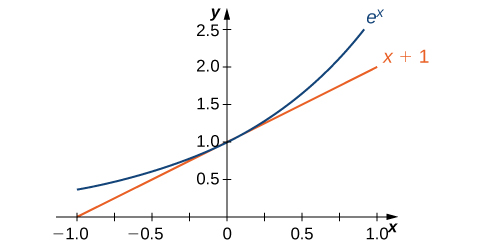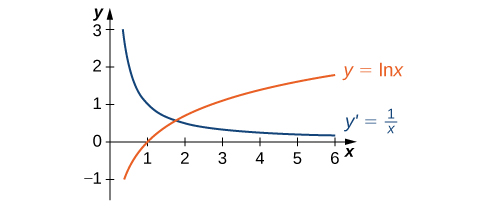Section 3.9 Derivatives of Exponential and Logarithmic Functions
Learning Objectives.
Find the derivative of exponential functions.
Find the derivative of logarithmic functions.
So far, we have learned how to differentiate a variety of functions, including trigonometric, inverse, and implicit functions. In this section, we explore derivatives of exponential and logarithmic functions. As we discussed in Exponential and Logarithmic Functions 1.7, exponential functions play an important role in modeling population growth and the decay of radioactive materials. Logarithmic functions can help rescale large quantities and are particularly helpful for rewriting complicated expressions.
Subsection 3.9.1 Derivative of the Exponential Function
Just as when we found the derivatives of other functions, we can find the derivatives of exponential and logarithmic functions using formulas.
We know that \(2.7182\lt e\lt 2.7183.\)
The graph of \(E(x)=e^x\) together with the line \(y=x+1\) are shown in Figure 3.138. This line is tangent to the graph of \(E(x)=e^x\) at \(x=0.\)

Now that we have laid out our basic assumptions, we begin our investigation by exploring the derivative of \(B(x)=b^x,b\gt 0.\) Recall that we have assumed that \(B'(0)\) exists. By applying the limit definition to the derivative we conclude that
Turning to \(B'(x),\) we obtain the following.
We see that on the basis of the assumption that \(B(x)=b^x\) is differentiable at \(0,B(x)\) is not only differentiable everywhere, but its derivative is
For \(E(x)=e^x,E'(0)=1.\) Thus, we have \(E'(x)=e^x.\) (The value of \(B'(0)\) for an arbitrary function of the form \(B(x)=b^x,b\gt 0,\) will be derived later.)
Theorem 3.139. Derivative of the Natural Exponential Function.
Let \(E(x)=e^x\) be the natural exponential function. Then
In general,
Example 3.140. Derivative of an Exponential Function.
Find the derivative of \(f(x)=e^{2x^2+x}.\)
Using the derivative formula and the chain rule,
Example 3.141. Combining Differentiation Rules.
Find the derivative of \(y=\frac{e^{x^2}}{x}.\)
Use the derivative of the natural exponential function, the quotient rule, and the chain rule.
Checkpoint 3.142.
Find the derivative of \(h(x)=xe^{2x}.\)
Example 3.143. Applying the Natural Exponential Function.
A colony of mosquitoes has an initial population of 1000. After \(t\) days, the population is given by \(A(t)=1000e^{0.3t}.\) Show that the ratio of the rate of change of the population, \(A'(t),\) to the population, \(A(t)\) is constant.
First find \(A'(t).\) By using the chain rule, we have \(A'(t)=300e^{0.3t}.\) Thus, the ratio of the rate of change of the population to the population is given by
The ratio of the rate of change of the population to the population is the constant 0.3.
Checkpoint 3.144.
If \(A(t)=1000e^{0.3t}\) describes the mosquito population after \(t\) days, as in the preceding example, what is the rate of change of \(A(t)\) after 4 days?
Example 3.145. Applying the Natural Exponential Function to an Account with Interest Compounded Continuously.
If \(A(t)=2500e^{0.012t}\) is the future value of an account in dollars with interest compounded continuously after \(t\) years, what is the rate of change of \(A(t)\) after 4 years?
First find \(A'(t).\) By using the chain rule, we have \(A'(t)=2500e^{0.012t}\cdot 0.012=30e^{0.012t}.\) Thus, the rate of change of the future value of the account after 4 years is given by
Subsection 3.9.2 Derivative of the Logarithmic Function
Now that we have the derivative of the natural exponential function, we can use implicit differentiation to find the derivative of its inverse, the natural logarithmic function.
Theorem 3.146. The Derivative of the Natural Logarithmic Function.
If \(x\gt 0\) and \(y=\ln x,\) then
More generally, let \(g(x)\) be a differentiable function. For all values of \(x\) for which \(g'(x)\gt 0,\) the derivative of \(h(x)=\ln (g(x))\) is given by
The graph of \(y=\ln x\) and its derivative \(\frac{dy}{dx}=\frac{1}{x}\) are shown in Figure 3.147.

Example 3.148. Taking a Derivative of a Natural Logarithm.
Find the derivative of \(f(x)=\ln (x^3+3x- 4).\)
Example 3.149. Using Properties of Logarithms in a Derivative.
Find the derivative of \(f(x)=\ln \left(\frac{x^2e^x}{5x+1}\right).\)
At first glance, taking this derivative appears rather complicated. However, by using the properties of logarithms prior to finding the derivative, we can make the problem much simpler. Applying properties of logarithms and then differentiating,
Checkpoint 3.150.
Differentiate: \(f(x)=\ln\left((3x+2)^5\right).\)
Now that we can differentiate the natural logarithmic function, we can use this result to find the derivatives of \(y=log_bx\) and \(y=b^x\) for \(b\gt 0,b\neq 1.\)
Theorem 3.151. Derivatives of General Exponential and Logarithmic Functions.
Let \(b\gt 0,b\neq 1,\) and let \(g(x)\) be a differentiable function.
If, \(y=\log_bx,\) then
\begin{equation} \frac{dy}{dx}=\frac{1}{x \ln b}.\tag{3.9.1} \end{equation}More generally, if \(h(x)=\log_b(g(x)),\) then for all values of \(x\) for which \(g(x)\gt 0,\)\begin{equation} h'(x)=\frac{g'(x)}{g(x) \ln b}.\tag{3.9.2} \end{equation}If \(y=b^x,\) then
\begin{equation} \frac{dy}{dx}=b^x\ln b.\tag{3.9.3} \end{equation}More generally, if \(h(x)=b^{g(x)},\) then\begin{equation} h'(x)=b^{g(x)}g\text{ ' }(x) \ln b.\tag{3.9.4} \end{equation}
Example 3.152. Applying Derivative Formulas.
Find the derivative of \(h(x)=\frac{3^x}{3^x+2}.\)
Use the quotient rule and Theorem 3.151.
Example 3.153.
Find the slope of the line tangent to the graph of \(y=\log_{2} (3x+1)\) at \(x=1.\)
To find the slope, we must evaluate \(\frac{dy}{dx}\) at \(x=1.\) Using (3.9.2), we see that
By evaluating the derivative at \(x=1,\) we see that the tangent line has slope
Checkpoint 3.154.
Find the slope for the line tangent to \(y=3^x\) at \(x=2.\)
Subsection 3.9.3 Key Concepts
On the basis of the assumption that the exponential function \(y=b^x,b\gt 0\) is continuous everywhere and differentiable at 0, this function is differentiable everywhere and there is a formula for its derivative.
We can use a formula to find the derivative of \(y=\ln x,\) and the relationship \(\log_bx=\frac{\ln x}{\ln b}\) allows us to extend our differentiation formulas to include logarithms with arbitrary bases.
Subsection 3.9.4 Key Equations
Derivative of the natural exponential function \(\frac{d}{dx}(e^{g(x)})=e^{g(x)}g'(x)\)
Derivative of the natural logarithmic function \(\frac{d}{dx}(\ln g(x))=\frac{1}{g(x)}g'(x)\)
Derivative of the general exponential function \(\frac{d}{dx}(b^{g(x)})=b^{g(x)}g'(x) \ln b\)
Derivative of the general logarithmic function \(\frac{d}{dx}(\log_bg(x))=\frac{g'(x)}{g(x) \ln b}\)
This book is a custom edition based on OpenStax Calculus Volume 1. You can download the original for free at https://openstax.org/details/books/calculus-volume-1.